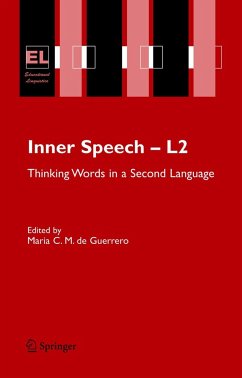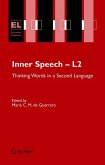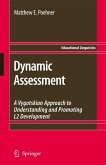The purpose of this book is to explore "inner speech" and its connections to second language (L2) learning. Inner speech, or silent self-directed speaking, enables the faculty to "think" words and is the main instrument for verbal thought. Inner speech originates in first language (L1) social discourse and develops in childhood through a process of internalization. In this book it is postulated that, given certain conditions of L2 learning, it is possible to develop L2 inner speech as a result of the interiorization of L2 social speech. Inner speech has been quite extensively investigated from an L1 perspective. The L2 acquisition field, however, has been slow in acknowledging the importance of inner speech in learning another language. Although within the past decade there have been some notable efforts to explore the topic from an L2 point of view, these efforts have remained in the form of isolated articles and short sections in larger volumes. This book reviews the extant literature on L1-L2 inner speech in its attempt to offer a coherent and comprehensive account of the phenomenon. The book draws mainly from Vygotskyan sociocultural theory for insights into the nature of L2 inner speech and the processes that engender it and characterize its development. The pedagogical implications of recognizing the crucial role inner speech plays in L2 learning are also addressed.
Inner Speech - L2 comprises a discussion of the historical and theoretical foundations of the concept of inner speech; a review of studies related to L1 and L2 inner speech and its methodology of research; an interpretive account of the origin, nature, and development of L2 inner speech from a sociocultural theory point of view; and various pedagogical implications and suggestions for further research.
According to Vygotsky (1986), The decreasing vocalization of egocentric speech denotes a developing abstraction from sound, the child's new faculty to "think words" instead of pronouncing them. This is the positive meaning of the sinking coefficient of egocentric speech. The downward curve indicates development toward inner speech, (p. 230) The purpose of this volume is to explore the faculty to "think words," not as the ability to mentally evoke words in the native (or first) language (LI) but as the faculty 1 to conjure up in the mind words in a second language (L2). To think words rather than to pronounce them is possible through inner speech, a function that humans develop in the course of childhood as they internalize the speech of the social group among which they grow. This means internalizing and being able to conduct inner speech in a particular linguistic code, the LI. But humans, at a very early or more mature age, may also come into contact and interact verbally with speakers of other languages, in classrooms or natural settings. The possibility thus emerges of internalizing an L2 in such a way that inner speech in the L2 might evolve. In this book, it is argued that, given certain conditions of L2 learning, it is possible for learners to attain inner speech in the L2. This book examines the distinctive nature of L2 inner speech and the processes that engender it and characterize its development.
Inner Speech - L2 comprises a discussion of the historical and theoretical foundations of the concept of inner speech; a review of studies related to L1 and L2 inner speech and its methodology of research; an interpretive account of the origin, nature, and development of L2 inner speech from a sociocultural theory point of view; and various pedagogical implications and suggestions for further research.
According to Vygotsky (1986), The decreasing vocalization of egocentric speech denotes a developing abstraction from sound, the child's new faculty to "think words" instead of pronouncing them. This is the positive meaning of the sinking coefficient of egocentric speech. The downward curve indicates development toward inner speech, (p. 230) The purpose of this volume is to explore the faculty to "think words," not as the ability to mentally evoke words in the native (or first) language (LI) but as the faculty 1 to conjure up in the mind words in a second language (L2). To think words rather than to pronounce them is possible through inner speech, a function that humans develop in the course of childhood as they internalize the speech of the social group among which they grow. This means internalizing and being able to conduct inner speech in a particular linguistic code, the LI. But humans, at a very early or more mature age, may also come into contact and interact verbally with speakers of other languages, in classrooms or natural settings. The possibility thus emerges of internalizing an L2 in such a way that inner speech in the L2 might evolve. In this book, it is argued that, given certain conditions of L2 learning, it is possible for learners to attain inner speech in the L2. This book examines the distinctive nature of L2 inner speech and the processes that engender it and characterize its development.
From the reviews: "Inner Speech-L2 is a comprehensive, well-written, and in-depth treatment of the complex topic of inner speech and its relevance for the filed of second language acquisition (SLA) ... . De Guerrero has provided the field with a solid and rich monograph on inner speech. Any researcher interested in the issue of thinking in an L2 and the complexities of the topic of language for thought and language of thought should read it." (Eduardo Negueruela, Modern Language Journal, Vol. 91 (4), 2007) "The book pinpoints the features of second language (L2) inner speech and analyses the processes which trigger its development. ... The book is addressed to scholars with a specific interest in sociocultural theory application, to researchers, educators, and students in the fields of L2 and Foreign Language (FL) learning, applied linguistics, language and cognition, and psycholinguistics. It might also be a useful resource book for those interested in gaining an understanding of the role played by inner speech in mediating language and thought." (Anna Franca Plastina, The Linguist List, February, 2008)








